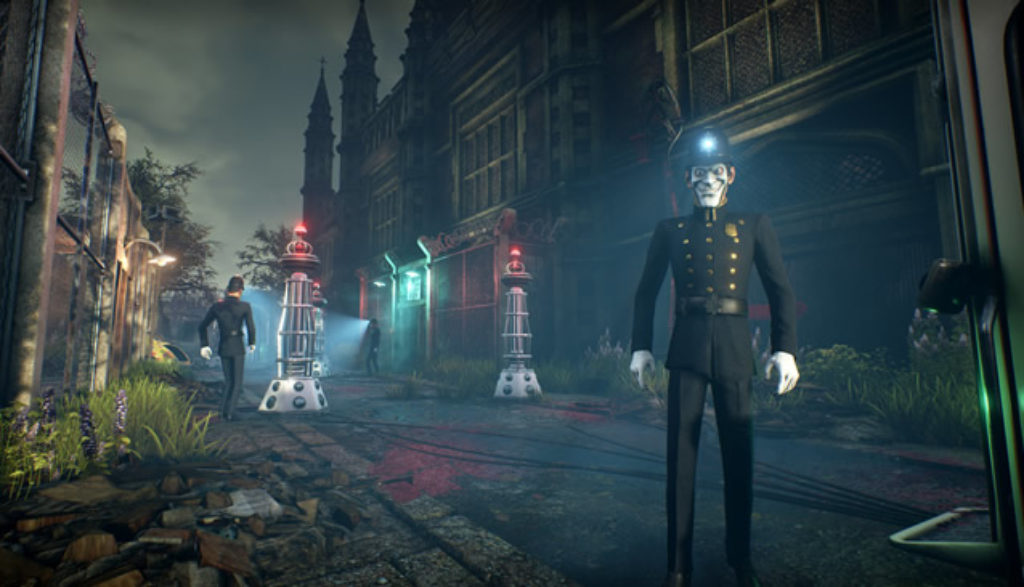
We live in a time when pretty much everyone wants to feel good about themselves. That doesn’t mean that everyone wants to necessarily be good or find a spiritual redemption to ease their troubled ways. In a sweeping, general sense, we simply want to … be happy. Yep, many believe that we all deserve to just get past those niggling little woes of life and become a collective crowd of cheery folks.
The game We Happy Few explores that self-numbing, nearly impossible belief system. It presents a world in which everyone has agreed that the only way to truly attain a state of even-keeled bliss is to be consistently high on a free-to-access drug.
Just don’t let anyone catch you clearing your head of that rainbow-hued, strawberry-flavored haze. ‘Cause if you do, things’ll get ugly.
This quirky and witty action-adventure title sets gamers up in a part of the British Isles with an alternate history. In this version of time and space, WWII didn’t exactly play out the same way we all remember. You see, the German’s won the big war there, and the British people had to make some rather terrible choices concerning their progeny. In fact, there are no children anywhere, these days.
But there’s plenty of Joy.
Joy is a government-produced drug that makes you see everything in this crumbling world through a lens of bright color and fluttering butterflies. And it makes you forget. You forget the past. You forget your worries. You forget the harsh realities of the world. You forget why you’re walking around in your always-grinning white mask. You just know that this is a world where everyone looks the same, feels the same and doesn’t care about much of anything other than making sure to take their Joy and watch the ever-cheerful Uncle Jack on the telly.
In this stylized reality—a combination of the sort of existence you might find in Orwell’s 1984 and Kubrick’s A Clockwork Orange—there are a few who don’t fit in. Those “Downers” who can’t tolerate Joy live outside the towns and villages in tattered clumps and bombed-out, rotting houses. They’re considered the dregs of society.
And then there’s you.
Gamers play as three different residents of the town of Wellington Wells. Arthur Hastings, Sally Boyle and Ollie Starkey have all quit taking their Joy and begun seeing and remembering things that the authorities prohibit. We play through each of their overlapping adventures, one after the other, and slowly piece together everything that has happened to society at large—and why it’s so important to find a way out while it’s still possible.
Gameplay-wise, players must fulfill scores of quests to facilitate that escape. And in a very real sense, We Happy Few is not only an adventure story but a game of crafting and survival. Players must manage their characters’ sleep and food intake. They have to learn how to sneak past officers and government agents on the street, as well as the citizenry of any given area. If the populace around you discovers that you’re not dressed right or taking the right drugs, its members will take off after you like a ravenous pack of hounds.
Because of those harsh realities, you’ll need to scrounge for supplies, foodstuffs and scraps of metal to use in crafting the right clothes, drugs and weapons to keep yourself upright and healthy. You’ll also have the option of popping a Joy pill now and again to slip by the wrong set of watching eyes or mechanized sensor.
But there are some negative side effects that players must deal with, too.
Ultimately, We Happy Few, with it’s Fallout-like dystopian adventure, raises some compelling questions about the choices we make in our real world. It asks us to consider the many ways we numb ourselves to reality or focus on inconsequential silliness rather than the true struggles of life. Theoretically, those are great questions to grapple with.
However, the game also happily indulges a plenty o’ problematic stuff of its own. The language here is pretty foul, well, most of the time, with blasphemies, f- and s-words and a variety of other gushing vulgarities regularly salting the dialogue. There’s no nudity in the digital camera’s eye, but we hear people talking about a variety of sexually suggestive topics (including a father figure’s abusive sexual seduction of a young girl). And we can roll back a window shade and catch some individuals involved in sadomasochistic activities.
Murder and mayhem aren’t really bloody here, but they’re pervasive. You can pound or slash just about anyone you choose to face off with. Then there’s all that drug use. It’s ostensibly condemned by the game’s narrative, but it’s still made light of in some ways. And you can even stumble upon a group of devil-worshipers who leave material offerings in a public square.
Add all of that up, and it’s the sort of content that should readily be avoided by younger gamers despite this title’s colorful, cartoony look. And even if you’re not under this game’s M-rated age threshold, there’s plenty of content here to steal away much of We Happy Few’s, uh, Joy.

After spending more than two decades touring, directing, writing and producing for Christian theater and radio (most recently for Adventures in Odyssey, which he still contributes to), Bob joined the Plugged In staff to help us focus more heavily on video games. He is also one of our primary movie reviewers.